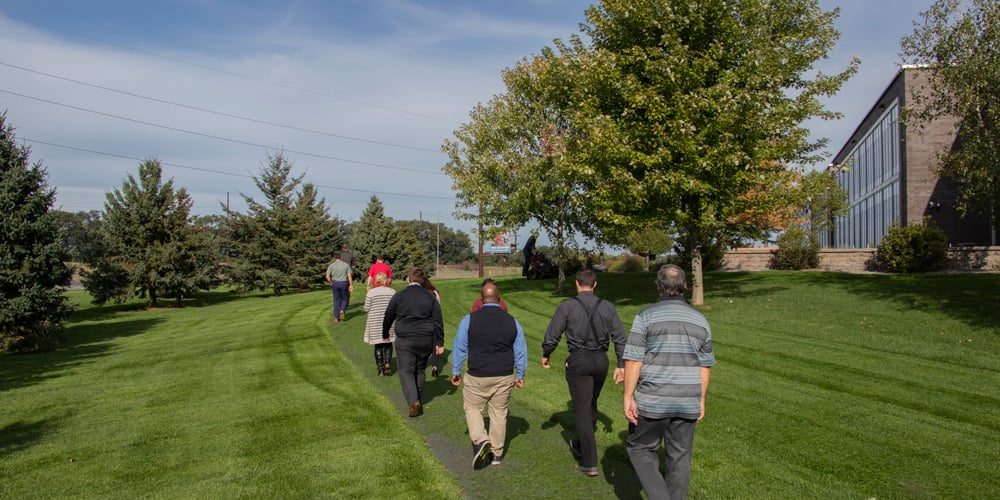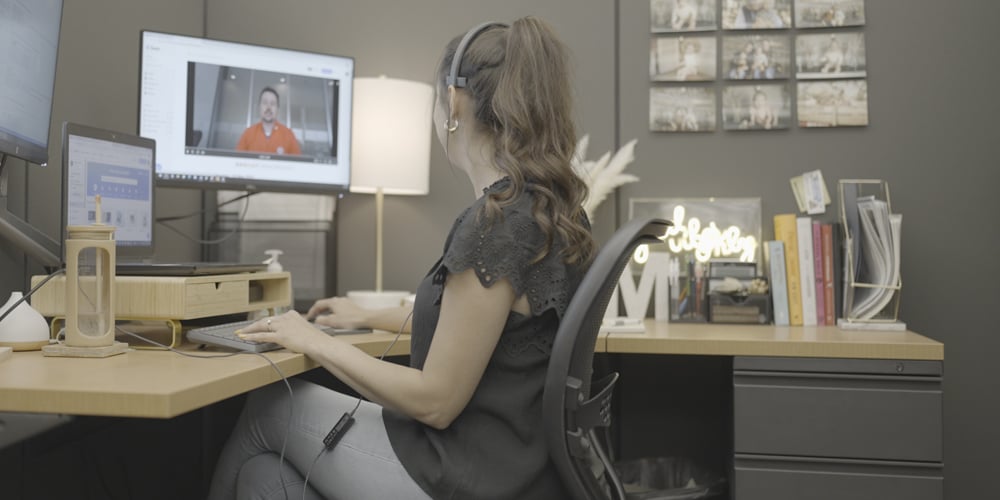 You’ve spent your career wandering from job site to job site or servicing customers in a retail or hospitality setting. You’re proud of the work you’ve done, but you’ve always wondered what it would be like to go to an office setting every day and get your work done behind a desk of your own.
You’ve spent your career wandering from job site to job site or servicing customers in a retail or hospitality setting. You’re proud of the work you’ve done, but you’ve always wondered what it would be like to go to an office setting every day and get your work done behind a desk of your own.
If you’re ready to take the leap and transition to an office job, that’s great! There’s a lot to like about the consistency that comes with going to the same place every day at the same time — along with the camaraderie of working alongside the same folks every day.
But, if you’re used to a job that takes place outside of an office setting, it’ll be an adjustment for you.
Since 1955, Anderson Trucking Service (ATS) has been hiring people in a variety of roles — including those in an office setting and those outside of one. So we understand what it takes to adjust from one type of role to the other.
Keep reading to learn seven tips for smoothly transitioning into an office job.
How Do I Adjust to Office Work?
If you’re considering making the switch to an office job — or have already committed to doing so — here are some key things to keep in mind. If you’re prepared for these adjustments, you’ll get off on the right foot:
- Make a conscious effort to move around
- Learn new/different technologies
- Prepare for a different type of exhaustion
- Get used to fewer face-to-face interactions
- Edit your wardrobe
- Adjust to a new schedule
- Adjust to a new type of pay
1. Make a Conscious Effort to Move Around
While this isn’t always the case, most out-of-office jobs require regular movement. Whether you’re doing manual labor on a construction site or serving food and drinks to customers, you’re moving a lot.
You can expect that type of movement to drop significantly in an office setting. Not that you’ll be sitting behind a desk nonstop — since you’ll likely attend meetings or walk to someone else’s desk — but you can expect much more sitting. A standing desk can help keep you on your feet more, but even that keeps you fairly stationary.
Outside of regular work functions, you can make sure you’re still “getting your steps in” by setting regular reminders to get up and move around. Whether you do that with a calendar reminder, a push notification on your phone or your favorite smartwatch, that type of alert can keep you motivated to move. Some offices might even have a walking path you can use throughout the day.

Maybe that phone call you’re about to make or email you’re about to press send on could be an in-person conversation. That’ll help you stretch your legs — and maybe even make a new connection — in the process.
2. Learn New/Different Technology
You’d be hard-pressed to find a job nowadays that doesn’t use technology in some form. But the technology you use in an office setting will more than likely be different than what you’re used to.
The point-of-sale systems will become desktop computers or laptops. The programs you’re used to in the field will probably turn into Microsoft products, like Word, Excel and Outlook (although that could vary by company).
If you’re not already comfortable reading articles or watching videos that teach you how to do things, now would be a good time to get acquainted. There’s a good chance you’ll be stuck on something in a program you’re not perfectly familiar with and need to do a quick search to find the solution. And that’s okay. We all do it. 🙂
And if you’re very unfamiliar with the “standard” office programs — like the Microsoft Office Suite — consider taking an online course or in-person classes at a local college to learn more about them.
3. Prepare for a Different Type of Exhaustion
If your current job requires manual labor or walking and talking, you probably come home from work physically exhausted fairly regularly. While you can likely kiss that physical exhaustion away with an office job, you might still find yourself exhausted after a day’s work — it’ll just be on the mental side.
Instead of coming home from work each day or night and trying to get off your feet following manual labor, you should consider stretching your legs and going for a nice, relaxing walk. Get some fresh air and think about things that don’t have to do with work.
Otherwise, consider a regular yoga or meditation routine to reduce stress.
4. Get Used to Fewer Face-to-Face Interactions
When people transition into the office, many of the jobs they come from — especially retail, restaurants and hospitality — deal with dozens of face-to-face interactions each day. Depending on your office job, you might still meet with people in person regularly, but the number of interactions will drop.
You’ll likely be on the phone or communicate via email more often — particularly with customers if you get a customer-facing role. You could still “scratch the itch” a bit, so to speak, by using one-to-one videos to communicate with your customers. That could also be a way to make you stand out amongst your competitors if the people you’re trying to do business with are used to getting “boring” emails all day.

Depending on the organization you work with and the role you take on, customer visits might still be possible. But you can’t expect them to occur at the frequency you’re used to in your non-office job.
5. Edit Your Wardrobe
Your needs here could vary, depending on the industry you’re coming from. But there’s a good chance you’ll be required to dress differently than you’re used to for work.
If that’s the case, it’s important to ask a business what its dress code policy is. The most popular dress code you’ll find is “business casual.” This dress code generally consists of collared shirts, like button-downs, polos and blouses, paired with dress pants, slacks, khakis or pencil skirts — although denim jeans are becoming more acceptable nowadays. Finally, you’ll find people wearing flats, heels, loafers or Oxfords if dressed for business casual.
That said, you should still make sure to ask an employer what they prefer. You can learn more about the different types of dress codes by reading our “What Should I Wear to Work or an Interview” article.
Don’t worry if your current wardrobe doesn’t include a lot of the required types of clothing you’ll need for your new office job. We don’t recommend going on a shopping spree — as fun as that sounds — to get more clothing.
Instead, gradually add to your wardrobe by shopping for a couple of staple pieces at a time — hopefully snagging a deal or two in the process. This will allow you to gauge what others are commonly wearing before you buy a bunch of stuff you can’t use.
6. Adjust to a New Schedule (If Applicable)
This could be the biggest adjustment of all, depending on what your current schedule looks like. While there’s usually some flexibility, you can expect to work somewhere along the lines of 8 a.m. to 5 p.m. Monday through Friday in an office environment.
If you’re used to sleeping in before working the second shift — or maybe even overnights — you’re going to want to prepare for your new sleep schedule ahead of time. After all, you don’t want to be falling asleep at your desk on your first day!

That doesn’t mean you have to go from waking up at 10 a.m. to setting your alarm for 6 a.m. immediately — in fact, that’s not recommended. If your work schedule allows for it, slowly start adjusting your alarm to be earlier, half an hour at a time. Adjusting incrementally will make it much easier to get used to your new schedule.
If getting up earlier sounds like a massive burden to you, try to find ways to reward yourself for getting up earlier. Maybe watch your favorite show in the morning with a cup of coffee. A morning walk with your dog can also be pretty rewarding. Find what makes you happy.
But what if you really like the hours of your second shift and still want an office job? That’s fine too. While it’s certainly less common, you can absolutely find office jobs that work outside “regular business hours” — including here at ATS.
7. Adjust to a New Type of Pay (If Applicable)
How you’re paid could be a big adjustment for you — especially if you’re coming from a tip-based industry. It can also be an adjustment if you’re used to working in an industry where you work a lot of overtime — and get compensated for it.
While it’s not the case across the board, many office jobs are exempt — or salaried — positions. That means you’ll earn the same amount on every paycheck, with no overtime. Whether that’s a good or bad thing is up to you. It will certainly bring more consistency to your bank account.
That said, there are some variations with this. Some positions will absolutely come with flat pay, as we mentioned above. Others though, will have a performance-based incentive — money you earn above and beyond your regular paycheck — whether it’s monthly, quarterly or annually. Some positions also rely heavily on commission, meaning the bulk of your paycheck will test your selling skills — kind of like tips!
The type of position you choose will be the deciding factor in the type of pay you can expect. Just be prepared to get paid differently than you do today.
Adjusting to Working in an Office
If you’re ready to change things, career-wise, and work in an office setting, change is absolutely what you can expect. While it will come in a variety of forms, depending on the type of role you apply for, you’re going to want to prepare for these seven things:
- Make a conscious effort to move around
- Learn new/different technologies
- Prepare for a different type of exhaustion
- Get used to fewer face-to-face interactions
- Edit your wardrobe
- Adjust to a new schedule
- Adjust to a new type of pay
Transitioning into an office-based career is possible — and a lot of people do it — but it will come with change. As long as you’re okay with that, and plan accordingly, you can make a successful transition too.
Ready to Make a Career Move?
If, after reading this article, making the move to an office sounds like a fit for you, we’d love to chat. ATS offers many different types of positions that require little or no experience — particularly experience in transportation. Get the training it takes to succeed and utilize the skills you already possess. Take a look at our current openings now to see what suits your wants and needs!



